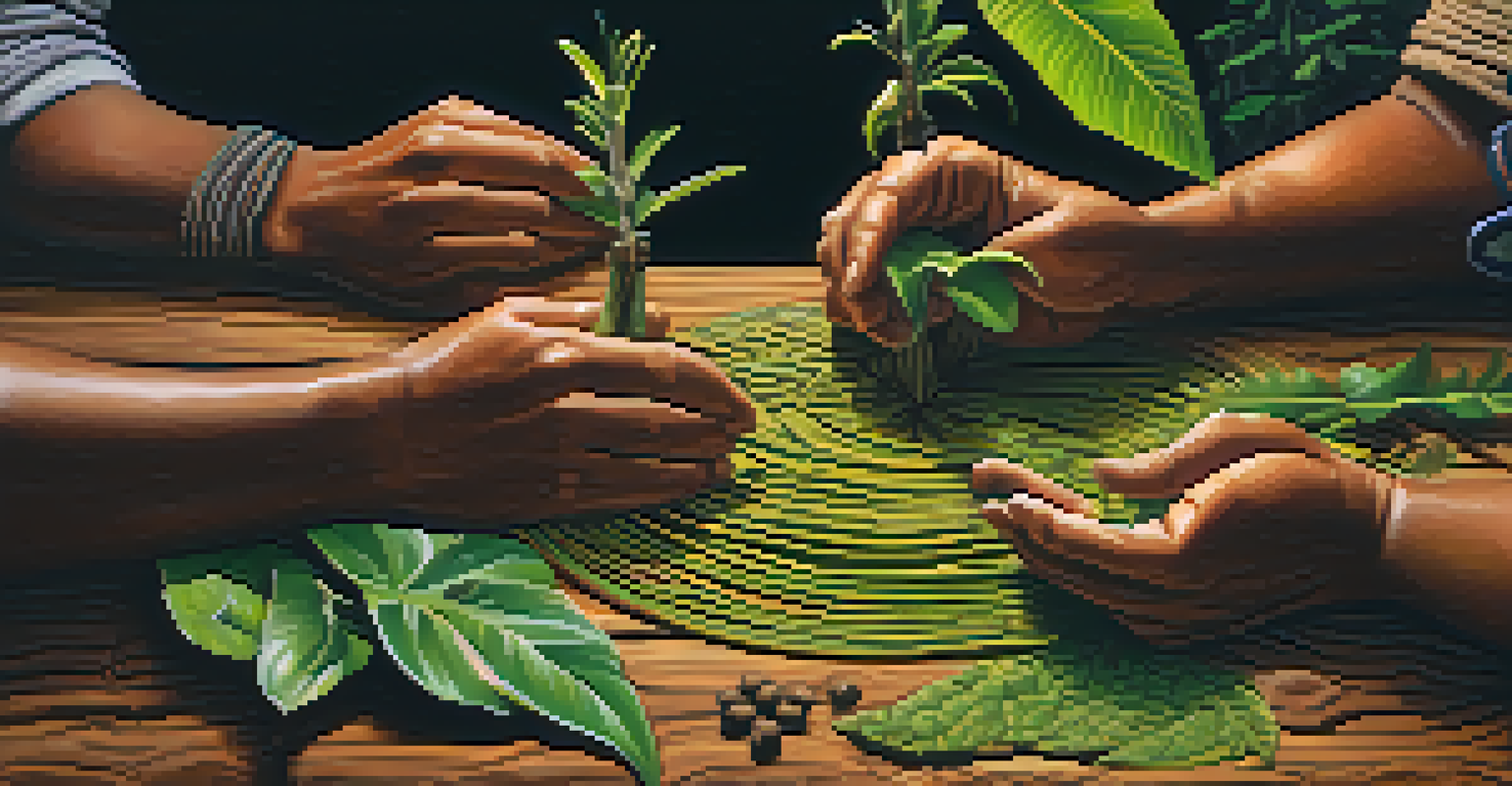Cultural Perspectives on Entheogens and Economic Inequity

Understanding Entheogens in Various Cultures
Entheogens, substances used in spiritual or religious contexts, have been integral to many cultures around the world. From the use of peyote in Native American rituals to ayahuasca in Amazonian shamanism, these substances often serve as bridges to deeper understanding and connection with the divine. Such cultural practices highlight the importance of these substances beyond mere recreation—they are tools for exploration of consciousness and community bonding.
The use of entheogens is a gateway to a deeper understanding of ourselves and a connection to the world around us.
In many Indigenous cultures, the use of entheogens is deeply rooted in tradition and spirituality, often passed down through generations. These practices are not only about personal experience but also about communal healing and resilience. When viewed through this lens, entheogens become a vital part of cultural identity, offering insights into the human experience that are often lost in modern society.
However, the growing interest in entheogens among Western societies raises questions about cultural appropriation and respect for these traditions. As these substances gain popularity, it’s essential to acknowledge and honor their origins while ensuring that the benefits are shared equitably among all communities.
The Connection Between Entheogens and Economic Inequity
Economic inequity often shapes who has access to the benefits of entheogens. In many cases, marginalized communities bear the brunt of legal restrictions and stigma associated with these substances. This disparity raises important questions about justice and equity in access to healing practices that have been historically significant to various cultures.

Moreover, the commercialization of entheogens can lead to further economic disparities. As lucrative markets develop around these substances, those who originally cultivated and utilized them for spiritual purposes may find themselves excluded from the benefits, often leading to cultural and financial exploitation. This scenario underscores a broader pattern of economic inequity that can occur when traditional practices are commodified.
Entheogens and Cultural Identity
Entheogens serve as vital tools for spiritual exploration and community bonding in many Indigenous cultures.
Addressing these inequities requires a collective effort to ensure that the voices and rights of Indigenous communities are respected. By advocating for policies that promote equitable access and benefit-sharing, we can work towards a future where entheogens are appreciated for their cultural significance and healing potential without perpetuating existing inequalities.
The Role of Legislation in Shaping Access to Entheogens
Legislation plays a crucial role in determining who can access entheogens. In many places, strict drug laws hinder the ability of individuals to explore these substances for personal or spiritual growth. This legal framework not only affects access but also contributes to the stigma attached to entheogens, often resulting in a lack of understanding of their potential benefits.
In respecting the traditions of Indigenous cultures, we honor the wisdom that has been passed down through generations, ensuring that healing practices are accessible to all.
In contrast, there is a growing movement advocating for the decriminalization and legalization of entheogens, particularly for therapeutic use. As more studies reveal the mental health benefits of substances like psilocybin and MDMA, policymakers are beginning to reconsider their stance. This shift offers hope for broader access, but it must be approached thoughtfully to avoid repeating past mistakes of exploitation.
Ultimately, the conversation around legislation should prioritize community voices, especially those from cultures that have historically used entheogens. By involving these communities in the legislative process, we can create frameworks that support healing and equity rather than perpetuating harm.
Cultural Healing Practices and Economic Resilience
Many cultures utilize entheogens as part of broader healing traditions that encompass physical, emotional, and spiritual well-being. These practices often foster resilience within communities facing economic challenges. By integrating entheogens into holistic healing approaches, individuals can address trauma and improve mental health in a culturally meaningful way.
For instance, in some Indigenous communities, ceremonies involving entheogens are not just about the substances themselves but also about the community, rituals, and shared experiences that accompany their use. This collective approach can enhance social bonds and build resilience against economic pressures. The act of coming together to heal creates a support system that is vital in times of hardship.
Economic Inequity in Access
Marginalized communities often face legal restrictions and exploitation regarding access to entheogens, highlighting issues of justice and equity.
These cultural practices highlight the importance of viewing health through a holistic lens, recognizing the interplay between mental, emotional, and economic wellness. As society increasingly acknowledges the value of these traditional methods, there is potential for fostering greater economic equity by supporting community-led initiatives that prioritize cultural healing.
Global Perspectives on Entheogens and Economic Inequity
Different countries have varied approaches to entheogens, which reflect broader societal values regarding spirituality and health. In countries like Brazil, where ayahuasca is embraced for its healing properties, there is a growing recognition of the need to protect Indigenous practices. This global perspective illuminates how cultural attitudes toward entheogens can either perpetuate or challenge economic inequities.
Conversely, in places where entheogens are criminalized, such as the United States, economic inequities are exacerbated by the legal risks associated with their use. Communities that historically used these substances may face penalties and stigma, limiting their access to traditional healing practices. This disparity raises critical questions about who gets to benefit from the resurgence of interest in entheogens.
By examining global perspectives, we can learn valuable lessons about equity and respect for cultural traditions. It's essential to advocate for policies that recognize the rights of Indigenous peoples while promoting access and understanding of entheogens as tools for healing across diverse communities.
Challenges of Cultural Appropriation in Entheogen Use
Cultural appropriation is a significant concern as entheogens gain popularity in Western contexts. When individuals from outside a culture adopt these substances without understanding their significance, it can lead to a dilution of their meaning and purpose. This not only disrespects the traditions of Indigenous communities but can also contribute to economic inequity by sidelining those who have historically used these substances.
For example, yoga and meditation have seen similar trends, where the commercialization in the West often overlooks their cultural roots. This pattern raises ethical questions about ownership and the responsibility of those engaging with these practices to honor their origins. The same principles apply to entheogens, where users should approach them with respect and a willingness to learn.
Legislation and Community Voices
Effective legislation around entheogens must prioritize the voices of Indigenous communities to ensure equitable access and healing practices.
Addressing these challenges requires open dialogue and education about the cultural contexts of entheogens. By fostering a greater understanding of their significance, we can create a more respectful and equitable environment for all communities involved in their use.
The Future of Entheogens and Social Equity
As the conversation around entheogens continues to evolve, there is a growing recognition of their potential for promoting social equity. By addressing the historical injustices faced by Indigenous communities and advocating for equitable access, we can foster a more inclusive approach to entheogen use. This perspective encourages us to view entheogens not just as substances but as vehicles for cultural healing and social change.
Moreover, the integration of entheogens into mental health treatment is gaining traction, offering hope for those facing economic and emotional struggles. As more people seek alternative therapies, it becomes increasingly important to ensure that these options are accessible to all, regardless of socioeconomic status. This shift can play a crucial role in bridging the gaps caused by economic inequities.

Ultimately, the future of entheogens in society will depend on our ability to respect cultural traditions while promoting healing for all. By empowering communities and prioritizing equitable access, we can ensure that the benefits of entheogens are shared broadly and meaningfully.